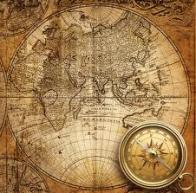'Haunting' art by Jewish children in WW2 concentration camp
 Helga Weissova, who was 14 when she was liberated, painted the girls' dorm ahead of an inspection by the Red Cross
Helga Weissova, who was 14 when she was liberated, painted the girls' dorm ahead of an inspection by the Red Cross A collection of sketches by Jewish children who were held at a concentration camp in the former Czechoslovakia during World War Two is going on show at a Lancashire gallery. The images offer an insight into the experiences of the children, many of whom later died in Nazi death camps.
When art is described as "truly haunting", it is usually because the artist has captured something immutable.
And while the works in a newly-opened Lancashire exhibition do just that, the description is more to do with who created them and where they were produced, than the subject matter of the pictures.
The show, at St Annes' Island Cinema, gathers together 40 works by children who were held at the Theresienstadt concentration camp in what was Czechoslovakia during World War Two.
 Pavel Sonnenschein, who died aged 13, painted the inside of a ghetto
Pavel Sonnenschein, who died aged 13, painted the inside of a ghetto Theresienstadt was, as the United States Holocaust Memorial Museum (USHMM) describes it, a "camp-ghetto", a transit camp for Jews which "served as a 'settlement', an assembly camp, and a concentration camp".
About 140,000 Jews were held at the camp, of which 15,000 were children. According to the USHMM, "approximately 90 percent of these children perished in death camps".
Brian Devlin, the exhibition's organiser, said that families at the camp understandably "tried to shield their children from the horror of their situation by occupying their free time with games, education and painting".
 Malvina Lowova, who was killed aged 12, drew a family being deported under armed guard while farmers armed with pitchforks threaten them
Malvina Lowova, who was killed aged 12, drew a family being deported under armed guard while farmers armed with pitchforks threaten them As a result, many pictures, drawings and paintings were produced and Mr Devlin said the works gave a glimpse into the minds of the children who produced them.
"One picture is an almost entirely black page - but you can make out the outline of a black train which, I suppose, is surrounded by the blackness of the doom that awaited," he said.
"Even the sun is surrounded by black.
"Another picture shows a mother and father and their children being shepherded through fields towards Theresienstadt.
"They are surrounded by angry farmers who are threatening them with pitchforks. It is very thought-provoking."
 Ruth Cechova, who died aged 13, painted her memories of sunbathing
Ruth Cechova, who died aged 13, painted her memories of sunbathing Not all of the pictures are as bleak, though, and there are many happier images showing children playing, as well as one sketch of a Passover feast.
"The Germans were very keen to use it as a 'show camp' to the rest of the world to demonstrate their alleged humanity," says Mr Devlin.
"Nevertheless, the paintings and drawings show clearly saddened victims [and] only a few are smiling."
 Vilem Eisner, who was 13 when he died, painted a lesson being held in a dorm room
Vilem Eisner, who was 13 when he died, painted a lesson being held in a dorm room The pictures have been loaned to the gallery by the Jewish Museum in Prague and will later go on tour around the UK.
Mr Devlin said the pictures were, without doubt, moving and saddening, but also very important.
"It is always valuable to see the world through the eyes of a child," he said.
"I see this art as voices from across the decades.
"Very few [from Theresienstadt] survived and the Nazis tried to eradicate their memory entirely. This art gives a voice to those victims."
The exhibition is at the Island Cinema in St Annes until 18 April.





